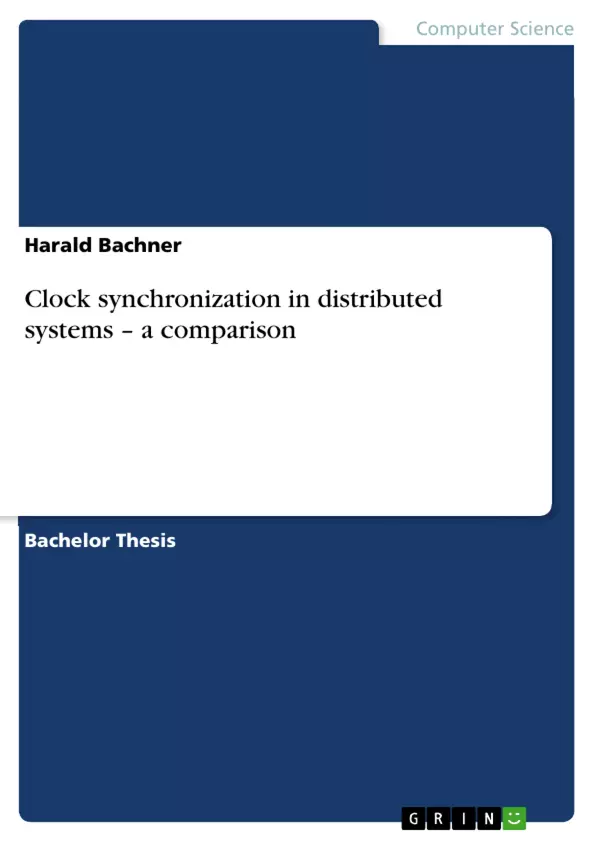Clock synchronization is a necessary and critical part in most distributed systems. For many years NTP was the state-of-the-art way of synchronizing computer clocks distributed in space. However, as recent advances in miniaturization lead to the construction of smaller, more powerful and less power consuming computers, embedded devices, sensors and actuators, the need for more precise time synchronization grew.
This work thus sets out to compare selected approaches to clock synchronization in distributed systems. The well known Global Positioning System is disseminating accurate time and frequency information from the International Institutes that keep the time, NTP can still do the same, but at different levels of accuracy as well as cost. Clock synchronization protocols like IEEE1588 or TTP and bus architectures like FlexRay evolved from the need to further propagate the timing information within small networks and therefore staying within the specified limits of preciseness.
Table of Contents
- 1. Task Definition.
- 2. Introduction
- 3. Clocks, Time and Frequency.
- 3.1. Clock Basics.
- 3.2. Current definition of a second of time
- 3.3. Coordinated Universal Time (UTC)
- 3.4. Types of Oscillators.
- 3.5. Time Dissemination.
- 3.5.1. Sources of Time Synchronization Errors
- 4. Selected Clock Synchronization Protocols and Mechanisms
- 4.1. The IEEE Standard 1588
- 4.1.1. Operational Overview.
- 4.1.2. PTP Time Stamping Implementations
- 4.1.3. Accuracy under Real Conditions
- 4.1.4. Pros and Cons
- 4.1.5. Conclusion
- 4.2. The Network Time Protocol (NTP).
- 4.2.1. Technical Details
- 4.2.2. Accuracy.
- 4.2.3. Pros and Cons.
- 4.3. Clock Synchronization with the Global Positioning System (GPS).
- 4.3.1. Technical Details
- 4.3.2. Accuracy.
- 4.3.3. Deployment
- 4.3.4. Pros and Cons.
- 4.4. FlexRay
- 4.4.1. Technical Details
- 4.4.1.1. Topology
- 4.4.1.2. Media Access
- 4.4.1.3. Bit Rates
- 4.4.1.4. Synchronizing the Nodes
- 4.4.1.5. Structure of FlexRay Nodes.
- 4.4.2. Pros and Cons.
- 4.4.3. Conclusion
- 4.5. The Time-Triggered Protocol (TTP).
- 4.5.1. Technical Details
- 4.5.2. Pros and Cons.
- 5. Conclusion.
Objectives and Key Themes
This bachelor thesis explores and compares various methods of clock synchronization in distributed systems. The primary objective is to analyze the strengths and weaknesses of prominent approaches, providing insights into their suitability for different network environments and applications.
- Different clock synchronization protocols and mechanisms
- The accuracy and precision of various time synchronization methods
- The pros and cons of each approach in terms of cost, complexity, and application suitability
- The development and evolution of clock synchronization techniques for embedded systems and distributed environments
- The impact of miniaturization and the increasing demand for precise timekeeping in modern networks
Chapter Summaries
Chapter 1 defines the scope and objectives of the thesis, outlining the research questions and providing an overview of the context. Chapter 2 offers an introduction to the concept of clock synchronization in distributed systems, highlighting the significance of accurate timekeeping in modern networked applications. Chapter 3 delves into the fundamental concepts of time and frequency, covering clock basics, the definition of a second of time, Coordinated Universal Time (UTC), types of oscillators, and the various sources of time synchronization errors. Chapter 4 presents a detailed comparison of selected clock synchronization protocols and mechanisms, including the IEEE Standard 1588, the Network Time Protocol (NTP), clock synchronization using the Global Positioning System (GPS), FlexRay, and the Time-Triggered Protocol (TTP). Each protocol is discussed in terms of its technical details, accuracy, advantages, disadvantages, and real-world applications.
Keywords
Clock synchronization, distributed systems, IEEE Standard 1588, Network Time Protocol (NTP), Global Positioning System (GPS), FlexRay, Time-Triggered Protocol (TTP), time dissemination, accuracy, precision, embedded systems, miniaturization, real-time applications
- Quote paper
- Harald Bachner (Author), 2007, Clock synchronization in distributed systems – a comparison, Munich, GRIN Verlag, https://www.grin.com/document/69617



